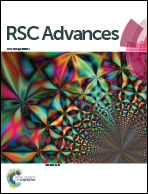Hydrothermal synthesis and adsorption behavior of H4Ti5O12 nanorods along [100] as lithium ion-sieves†
Abstract
The adsorption method is a promising route to recover Li+ from waste lithium batteries and lithium-containing brines. To achieve this goal, it is vital to synthesize a stable and high adsorption capacity adsorbent. In this work, Li4Ti5O12 nanorods are prepared by two hydrothermal processes followed by a calcination process. Then the prepared Li4Ti5O12 nanorods are treated with different HCl concentrations to obtain a H4Ti5O12 adsorbent with 5 μm length along the [100] direction. The maximum amount of extracted lithium can reach 90% and the extracted titanium only 2.5%. The batch adsorption experiments indicate that the H4Ti5O12 nanorod maximum adsorption capacity can reach 23.20 mg g−1 in 24 mM LiCl solution. The adsorption isotherms and kinetics fit a Langmuir model and pseudo-second-order model, respectively. Meanwhile, the real adsorption selectivity experiments show that the maximum Li+ adsorption capacity reaches 1.99 mmol g−1, which is far higher than Mg2+ (0.03 mmol g−1) and Ca2+ (0.02 mmol g−1), implying these nanorods have higher adsorption selectivity for Li+ from Lagoco Salt Lake brine. The adsorption capacity for Li+ remains 91% after five cycles. With the help of XPS analyses, the adsorption mechanism of Li+ on the H4Ti5O12 nanorods is an ion exchange reaction. Therefore, this nanorod adsorbent has a potential application for Li+ recovery from aqueous lithium resources.
![Graphical abstract: Hydrothermal synthesis and adsorption behavior of H4Ti5O12 nanorods along [100] as lithium ion-sieves](/en/Image/Get?imageInfo.ImageType=GA&imageInfo.ImageIdentifier.ManuscriptID=D0RA05094F&imageInfo.ImageIdentifier.Year=2020)


 Please wait while we load your content...
Please wait while we load your content...